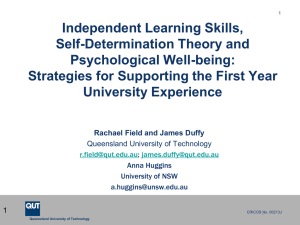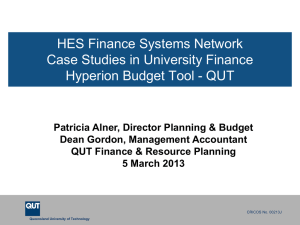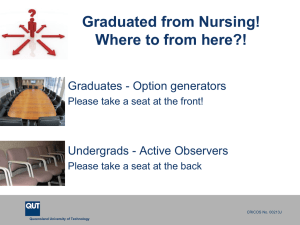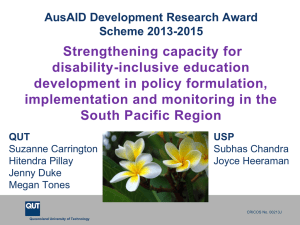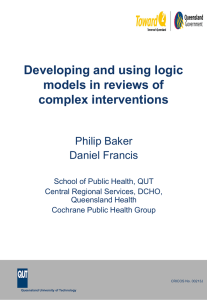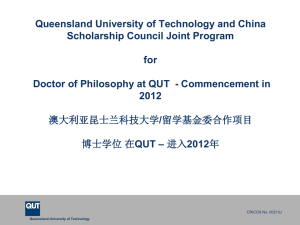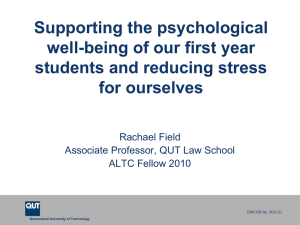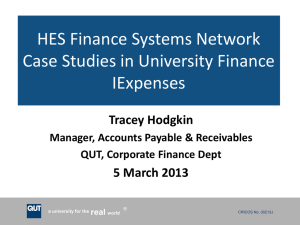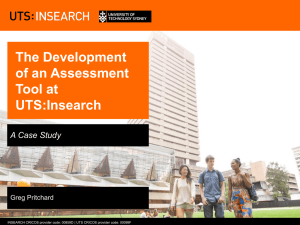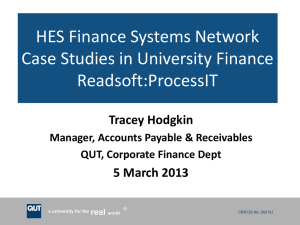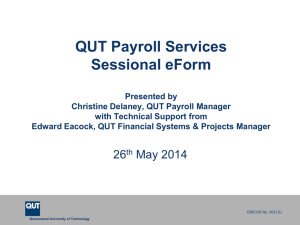slides
advertisement
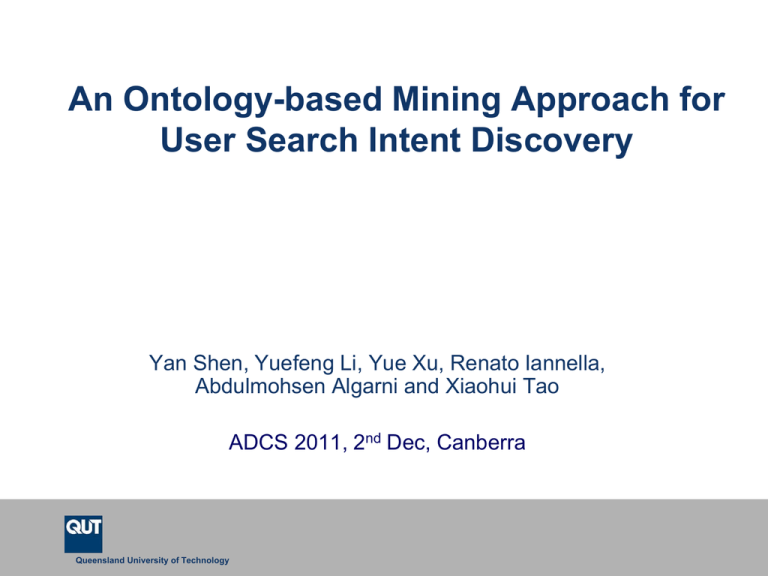
An Ontology-based Mining Approach for User Search Intent Discovery Yan Shen, Yuefeng Li, Yue Xu, Renato Iannella, Abdulmohsen Algarni and Xiaohui Tao ADCS 2011, 2nd Dec, Canberra Queensland University of Technology Outline • Introduction • Related work • Proposed Approach – – – – An overview of the architecture World knowledge base Personalized ontology construction In-levels ontology mining method a university for the real world R CRICOS No. 00213J 2 Outline • Evaluation – – – – Data collections Measures & Baseline model Results and findings Discussion • Conclusion and future work a university for the real world R CRICOS No. 00213J 3 Introduction • Retrieving desired information to a user is the primary objective of an effective search engines • Many efforts are spent to improve search capabilities, e.g…. • No doubt that they are helpful, however, they are commonly encountering an issue – information mismatch (ambiguity) a university for the real world R CRICOS No. 00213J 4 Introduction • To overcome the issue, more and more researchers have taken ontologies into account • The ontologies can classify diverse knowledge into a wellstructured way, which facilitate users to assess information items • Moreover, semantic relations can be considered to enhance information navigation a university for the real world R CRICOS No. 00213J 5 Introduction • Note that user search intent is a significant aspect to return desired information • We study search intents into two means: Specificity and Exhaustivity intent • A hierarchical concept level-finding technique is proposed to discover and characterize user search intents a university for the real world R CRICOS No. 00213J 6 Introduction • an ontology-based approach is introduced • Library of Congress Subject Headings is applied as a world knowledge base for learning personalized ontologies • In-levels ontology mining method is fully described • Evaluated by 100 RCV1 topics in TREC 2002 Filtering Track • The results indicate that the performance of top precision is improved dramatically. a university for the real world R CRICOS No. 00213J 7 Related work • Ontology-based techniques – Zhong proposes a learning approach for task (or domain-specic) ontology, which employs various mining techniques and naturallanguage understanding methods. – Li and Zhong present an automatic ontology learning method, in which a class is called a compound concept, assembled by primitive classes that are the smallest concepts and cannot be divided any further. – … a university for the real world R CRICOS No. 00213J 8 Related work • Ontology-based techniques – They don't consider the purpose of discovering and characterizing user search intents in a concept level. – To extend the previous methods, the paper uses “Is-A“ relation to build a real hierarchical structure for the backbone of personalized ontologies a university for the real world R CRICOS No. 00213J 9 Related work • User information needs – Jiang and Tan aim to represent and capture users' interests in target domain. Subsequently, a method, they called Spreading Activation Theory (SAT), is employed for providing personalized services. – Tao et al. propose an ontology-based knowledge retrieval framework to capture user information needs by considering user knowledge background and user's local instance repository with association roles and data mining techniques. – … – They are normally either expensive in extraction or inaccurate in description. a university for the real world R CRICOS No. 00213J 10 Proposed approach • The paper first holds a hypothesis that a user search intent should exist somewhere in an ontology. • The intent could be general or specific, and can be represented in a range of extent a university for the real world R CRICOS No. 00213J 11 Proposed approach • An overview of the approach a university for the real world R CRICOS No. 00213J 12 Proposed approach • World knowledge base (LCSH) – In the LCSH, subject headings are basic semantic units for conveying domain knowledge and concepts, they have three main types of references: Broader Term, Narrower Term and Related Term. – Refine to ancestor and descendant lexical relations respectively in our approach a university for the real world R CRICOS No. 00213J 13 Proposed approach • World knowledge base (cont.) – Definitions a university for the real world R CRICOS No. 00213J 14 Proposed approach • Personalized ontology learning – Concept hierarchy is an essential object of ontology learning – Here, we create an abstract hieratical structure a university for the real world R CRICOS No. 00213J 15 Proposed approach • Personalized ontology learning (cont.) – Definitions a university for the real world R CRICOS No. 00213J 16 Proposed approach • Personalized ontology learning (cont.) – An example a university for the real world R CRICOS No. 00213J 17 Proposed approach • In-Levels ontology mining method – Represent feature in levels (two objectives) • 1) to decide subjects and weights for the pilot level; • 2) to represent it as a query After that, do a query expansion. Then, obtain a feature as: a university for the real world R CRICOS No. 00213J 18 Proposed approach • In-Levels ontology mining method (cont.) – Determine the best level for user search intents a university for the real world R CRICOS No. 00213J 19 Evaluation • Data collections – A LCSH (QUT Library data in 2008) database 719 mega bytes data stored in Microsoft Office Access Database (.mdb), totally 491,250 subjects associated with semantic relations – TREC-11 2002 Filtering Track, RCV1, totally 806,791 xml documents in training and testing sets. – All of them are processed by the pre-processing approach (stopwords removal, stemming) a university for the real world R CRICOS No. 00213J 20 Evaluation • Measures & Baseline model – Top 20 precision (pr@20), the precision averages at 11 standard recall levels (11-points), the Mean Average Precision (MAP), and the F1-Measure. – ONTO model (Tao et al., 2010) – Two uniform level settings in upper level 7 and lower level 2 respectively. a university for the real world R CRICOS No. 00213J 21 Evaluation • Results and Findings a university for the real world R CRICOS No. 00213J 22 Evaluation • Results and Findings (cont.) a university for the real world R CRICOS No. 00213J 23 Evaluation • Results and Findings (cont.) a university for the real world R CRICOS No. 00213J 24 Evaluation • Discussion – The approach by only containing new terms has better performance than the one keeps all the terms in levels – Demonstrate the validity of the hierarchical backbone – The experimental results are indistinct for all the measures, and those specific terms might be able to reduce recall – The approach is suitable to situations when precision is be considered more important than others – LCSH is difficult to keep up to date a university for the real world R CRICOS No. 00213J 25 Conclusion • The paper introduces an ontology-based approach to discover user search intents • The approach involves a subject-based search model, a world knowledge base, and a in-levels ontology mining method • The empirical results indicate that our approach works remarkable on top precision • The main intellectual contribution is the hierarchical level-finding technique a university for the real world R CRICOS No. 00213J 26 Future work • Investigate the usage of the rest of semantic relations in LCSH • Combine with pattern mining methods • Test the approach with other world knowledge base, like WordNet or Amazon a university for the real world R CRICOS No. 00213J 27 • Thank you for listening, any question? a university for the real world R CRICOS No. 00213J 28
